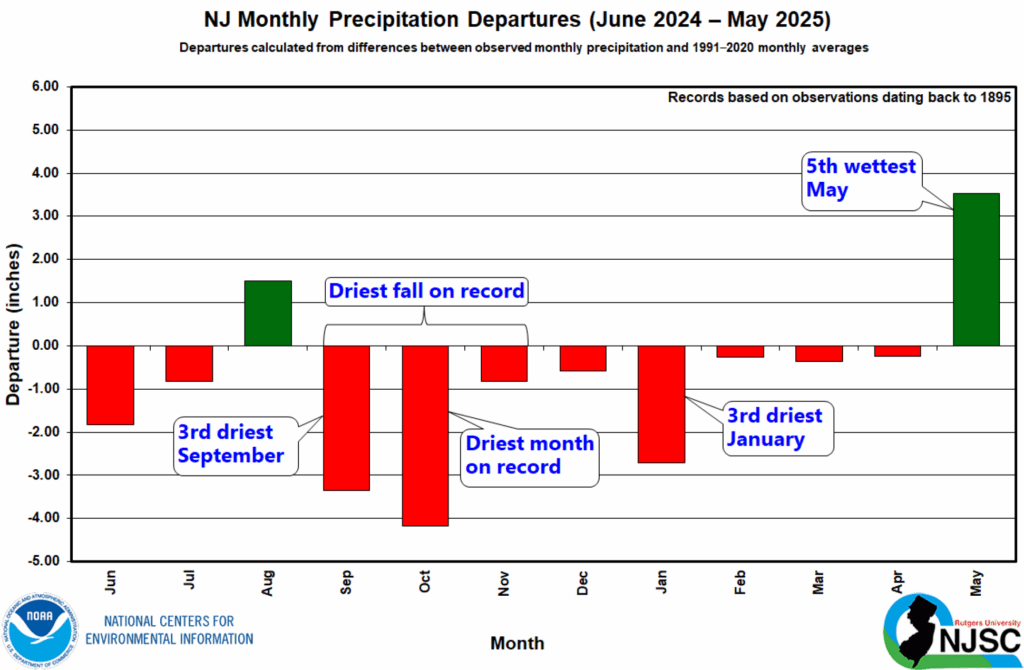Main Content
Amy Rowe, Rutgers Cooperative Extension
New Jersey had a record-setting drought during the fall of 2024, with October being the driest month ever recorded for the state going back to 1895. The state received only 0.02 inches of precipitation on average that month, which is 4 inches below normal. The exceedingly dry fall led to the drought continuing into 2025.
You may have noticed that New Jersey has been receiving a lot of rainfall recently, especially in May. These precipitation events have been allowing New Jersey’s water supplies to come back to normal conditions even though many residents are not happy with the many rainy weekends we’ve had in a row.
Governor Murphy lifted the drought warning that had been in place across the entire state on June 11th, after recent precipitation improved water supplies. The Coastal South drought region will continue to be in a drought watch, but the rest of the state’s water supply status has been upgraded to “normal,” according to the New Jersey Department of Environmental Protection’s (NJDEP) Drinking Water Supply Indicators. (dep.nj.gov/drought/current-conditions/ ) See Figure 1 for the drought regions. A drought watch indicates that conditions are dry but not yet significantly so, while a drought warning is a non-emergency water management stage that urges the public to voluntarily conserve water.

Figure 1. Drought regions of New Jersey. All regions are at normal water supply levels except the Coastal South (light blue), which is in a drought watch. Map from dep.nj.gov/drought/drought-regions-in-new-jersey/.
How did we get here?
New Jersey kicked off the year with the third-driest January on record with less than 1 inch of precipitation recorded (Table 1). February, which is usually a snowy month for the state, saw only 2.53 inches of total precipitation. The rainfall for March was below normal at just over 4 inches. April brought precipitation that was just above normal, with May proving to be the 5th wettest on record with 3.5 inches more rainfall than normal.
Table 1. Average precipitation received, departure from average, and historical rank for January – May 2025 for the whole state of New Jersey.
| Month | Statewide precipitation average | Comment and Historical classification |
| January 2025 | 0.92 inches | 2.57 inches BELOW normal, 3rd driest Jan |
| February 2025 | 2.53 inches | 0.33 inches BELOW normal, 50th driest Feb |
| March 2025 | 4.02 inches | 0.18 inches BELOW normal, 73rd driest March |
| April 2025 | 3.72 inches | 0.02 inches ABOVE normal, 63rd wettest April |
| May 2025 | 7.27 inches | inches ABOVE normal, 5th wettest May |
Table compiled using data from www.njweather.org.
Figure 2 shows the precipitation departure, either above (green) or below (red) from the recent state monthly averages (1991–2020). The records that are called out in the text bubbles look back to 1895. The graph visually emphasizes the incredibly dry fall of 2024 and the extremely wet May of 2025. Bars that are close to the zero line indicate that the precipitation was close to the average or expected rainfall that month.

Figure 2. New Jersey monthly precipitation departures for June 2024 through May 2025. Chart from climate.rutgers.edu/stateclim/
Help conserve water!
Although the state is generally back to “normal” water supply conditions, the NJDEP is recommending that residents follow water conservation practices as we move into the hot summer months. It’s possible that dry conditions will arise as temperatures climb and using water wisely will assist the state in managing water supplies. Here are some suggestions from NJDEP (dep.nj.gov/conserve-water/ ).
Things you can do to conserve water inside your home:
- Install high-efficiency appliances such as dishwashers and washing machines.
- Install low-flow showerheads, faucets, and toilets to maintain pressure at lower volume of water used.
- Check for and fix leaks around sinks, appliances, and toilets.
- Turn off the faucet while brushing your teeth.
- Take 5-minute showers.
- Run appliances when they are full.
Things you can do to conserve water outside your home:
- Build your soil with compost and mulch to hold water and reduce evaporation.
- Raise your lawn mower blade to at least 3 inches, as taller grass promotes deeper roots, shades the root system, and holds soil moisture better than a closely cropped lawn.
- Reduce thatch in your lawn to increase water infiltration. Thatch is a layer of grass, leaves, roots, and other organic matter that accumulates between living grass and the soil surface.
- Choose grass species that are drought tolerant such as fine leaf or tall fescues.
- Install a rain barrel so plants can be irrigated using harvested rainwater. Here’s how you can make your own: njaes.rutgers.edu/E329/
- Choose native plants that are adapted to our climate and require less water. Check out this video on starting a native plant garden (youtu.be/FI8M2bQXogE).
- Group plants together based on water needs so that you water certain zones rather than the whole yard.
- Use drip irrigation, where possible, to reduce water usage by 30% – 50% compared to conventional watering systems.
- Water plants in the morning when winds are generally calm and temperatures are cooler. Watering in the evening can make plants susceptible to fungal diseases.
- Water deeply more often rather than watering every day, which can promote shallow root growth. Generally, plants need 1 inch of water per week, including rainfall. A rain gauge can show you when watering is needed.
- Keep a cover on your pool when not in use to reduce evaporation.
- Wash your car at a car wash rather than at home, as many facilities recycle the water.
Thank you for doing your part to make sure we have plentiful water supplies this summer!
Resources
Rutgers New Jersey Weather Network
www.njweather.org
Office of the New Jersey State Climatologist
climate.rutgers.edu/stateclim
Jersey-Friendly Yards Water Wisely
www.jerseyyards.org/create-a-jersey-friendly-yard/8-steps/step-3-water-wisely/